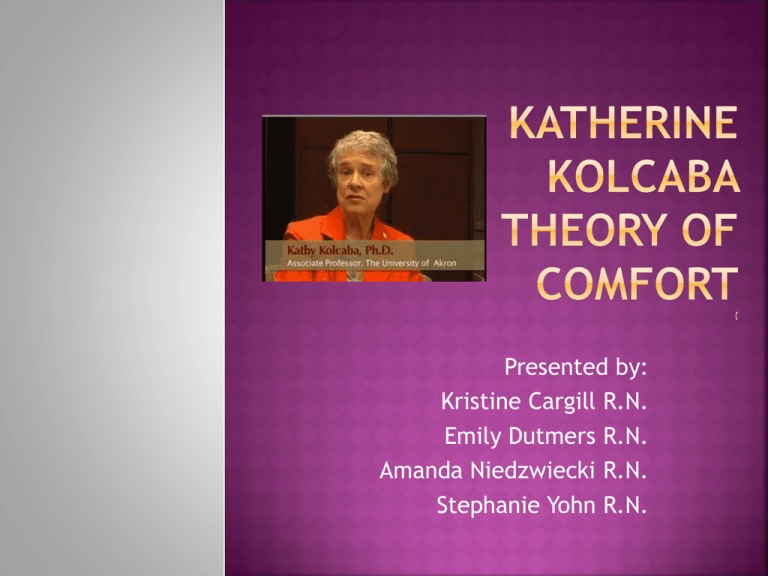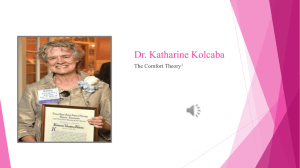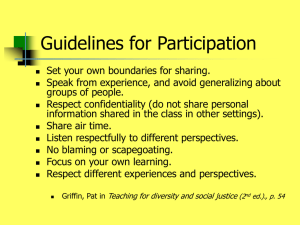Katherine Kolcaba Theory of comfort
advertisement

Presented by: Kristine Cargill R.N. Emily Dutmers R.N. Amanda Niedzwiecki R.N. Stephanie Yohn R.N. “Comfort may be a blanket or breeze, some ointment here to soothe my knees; a listening ear to hear my woes, a pair of footies to warm my toes; A PRN medication to ease my pain, someone to reassure me once again; A call from my doctor, or even a friend, a rabbi or priest as my life nears its end. Comfort is whatever I perceive it to be, a necessary thing defined only by me.” -S.D. Lawrence (student nurse) (Kolcaba, 2003, p.1) Comfort Theory originated from a Masters program assignment – to diagram her nursing practice At that time, she was a head nurse on an Alzheimer unit Comfort was the state she wanted her Alzheimer patient’s to be in when not participating in activities or tasks. Comfort became her focus in nursing practice and research Comfort theory was later applied to other fields of nursing, such as perioperative care and pediatrics http://www.thecomfortline.com/index.html Nursing care is more efficient when theory is used because care can be delivered in an organized manner Science of nursing is about the comfort of patients, families, and nurses When nurses provide comfort measures, such as turning a patient every 2 hours, the patient is expected to have a positive outcome Care is delivered and based on a humanistic and holistic approach and patients’ needs (Kolcaba, 1991) Research has included the care nurses provide and the comfort or patient outcomes that result from the care provided Values the whole person Prior theories included comfort but had not been defined yet Kolcaba’s definition of comfort (2003): “Holistic comfort is defined as the immediate experience of being strengthened through having the needs for relief, ease, and transcendence met in four contexts of experience (physical, psychospiritual, social, and environmental)” (p.16). Three Types of Comfort Relief- adapted from Ida Jean Orlando’s work: nurses relieve patient’s needs Ease – adapted from Virginia Henderson’s work: human functions necessary for homeostasis Transcendence – adapted from Josephine Paterson and Loretta Zderad’s work: patients improve with the help of nurses (Kolcaba, 1991) Four Contexts of Comfort Physical Psychospiritual Environmental Social Kolcaba recognized that discomfort is more than just a painful physical sensation or emotional pain that is felt. Instead she concluded that other aspects of comfort or discomfort affect holistic beings. Kolcaba defined the three types of comfort: Relief- experience of a patient who has had a specific comfort need met Ease- a state of calm or contentment Transcendence- the state in which one rises above problems of pain These types of comfort are addressed by means of the four contexts: Physical- pertaining to sensations (pain, cold, heat, tingling), homeostatic mechanisms (temperature control, bleeding, vomiting- can all disrupt this area) or function of the immune system. Psychospiritual- pertaining to internal awareness of self, including esteem, identity, sexuality, meaning in ones life, and one’s feelings or belief in a higher power or superior being. Environmental- pertaining to the external background of human experience (temperature, light, sound, odor, color, furniture, landscape) Sociocultural- pertaining to interpersonal, family and societal relationships; also includes family traditions, rituals and religious practices. (Kolcaba, 2006) When combined, the three types of comfort and 4 contexts create a 12 cell grid, referred to as the taxonomic structure, which was created by Kolcaba in 1991. This can be used as a guide when assessing a patient’s level of comfort. These aspects of comfort are interrelated with one another. Kolcaba did not mean for them to be measured exactly because she felt the process would be time-consuming and inaccurate (Kolcaba, 2003). However, a pattern of care can be established whereby patients comfort needs are intuitively assessed in the 4 contexts. Context of Comfort Physical Psychospiritual Environmental Social Type of Comfort Relief Ease Transcendence Now lets look at the four global concepts of the nursing metaparadigm in relation to Katherine Kolcaba’s Comfort Theory. Human beings Environment Health Nursing This includes all in need of health care- individuals, families and entire communities or institutions. The aspect of comfort is an important and innate need to be attained. All humans deserve to be as comfortable as possible. Patient focused care is integral to attaining comfort. When patients are more comfortable, they are more likely to engage in health seeking behaviors-including internal or external behaviors or even a peaceful death. The strengthening properties of comfort produce better patient outcomes. (Kolcaba, 2003) Manipulation of the external surroundings of the patient to facilitate comfort. By means of touch, sights, sounds, lighting or odors to promote a calming, comforting atmosphere. Any way that the senses can be altered to enhance comfort of the patient applies. Having an understanding of the patient’s cultural, religious or spiritual preferences and including them in care promotes comfort. When the words and actions of the nurse are comforting, in addition to the intent of providing comfort, the interventions are often perceived more as a comfort measure by the patients (Kolcaba, 2003). Eliminate negativity in the environment if possible- promote positive thinking and attitudes. According to Katherine Kolcaba (2003), “Health is comfort” (p. 35) The optimum level of functioning that is appropriate for and defined by each individual patient. To be in good health a patient must attain what THEY consider their highest degree of comfort. Comfort is a positive, dynamic state and the health care team can do more to enhance comfort if they go beyond the treatment of discomforts and physical health (Kolcaba, 2003). When one of the 4 contexts or 3 types of comfort is not balanced or being met, the patient may not be at their highest level of wellness or health along the health continuum. Continual, active use of the nursing process to assess the comfort of the patient and address their needs to attain comfort. Assessing and reassessing whether the interventions implemented were successful in improving the comfort of the patient. Providing competent empathetic, compassionate, skilled and holistic nursing care to each patient, without inflicting judgment. Maintaining a strong, trusting nurse-patient relationship and involving the patient in meeting their comfort needs and goals will make the process more successful. (Kolcaba, 2006) Interventions for the patient are based on needs of the patient as well as family needs Comfort needs are intermixed. Meeting one need may, in turn, fill another need When comfort needs are fulfilled, the patient feels safe and well cared for. (Kolcaba, 1995) When comfort tasks such as cleaning up room or straighting sheets are preformed, patients feel cared for. Patients who have less stress have better outcomes Nurses feel more job satisfaction because even the smallest tasks bring comfort to their patients. Clarification of Origins Katherine’s philosophy evolved from holism, human needs and Murray’s Theory of Human Press (1938) and was designed only for nursing (Kolcaba, 2003 pp. 60-66). It was just recently that Katherine thought about a 4th philosophy from nursing (Kolcaba, 2003, p. 66 para 2). Henry Murray Proposal for use of Kolcaba’s Theory in other healthcare practices has been formulated to change “nursing interventions” and redefine as “comfort interventions.” (March & McCormick, 2009). Kolcaba expresses her comfort theory in all 4 concepts of the nursing metapardigm. Advanced Directives- guide to make decisions about care and pain management (Vendlinski & Kolcaba, 1997) PerianesthesiaClinical Practice Guidelines (retrieved from http://www.aspan .org/) The Comfort Theory Psychiatric Nursingguided imagery to relieve depression and increase comfort (Apostolo & Kolcaba, 2009) Healthy Bladder Program for Urinary Incontinence in older adults (Schirm et al., 2004) Pediatrics-assisting the child with self comforting actions such as “rocking” (Kolcaba & DiMarco, 2005) 15 year old female, diabetic patient was admitted to the hospital for a second time in one month with hyperglycemia. She was found to be crying and withdrawn, curled up in the fetal position in the dark. Staff is concerned because she does not want to participate in administering insulin, checking her blood sugars, and meal planning. She indicates that she feels different than everyone else and wants to be able to eat whatever she wants. Context of Comfort Physical Psychospiritual Environmental Sociocultural Types of Comfort Relief Ease Transcendence Apostolo, J.L.A., & Kolcaba, K., (2009). The effects of guided imagery on comfort, depression, anxiety, and stress of psychiatric inpatients with depressive disorders. Archives of Psychiatric Nursing, 23(6), 403-411 Kolcaba. (1991). A Taxonomic Structure for the. Journal of Nursing Scholarship , 23 (4), pp. 237-240. Kolcaba, K. (1995). Comfort as process and product,merged in holistic nursing art. Journal of Holistic Nursing, 128-129. Retrieved from http://jhn.sagepub.com/content/13/2/117 Kolcaba, K. (2003). Comfort theory and practice: A vision for holistic health care and research. p. 9-17, 34-35, 59-68. Springer Publishing Company: New York. Kolcaba, K., & DiMarco, M. A. (2005). Comfort theory and its application to pediatric nursing. Pediatric Nursing, 31(3), p. 187-194. Retrieved from PubMed Kolcaba, K, Tilton, C., & Drouin. (2006). Comfort theory: a unifying framework to enhance the practice environment. The Journal of Nursing Administration, 36(11), p538-544. Retrieved from: http://journals.lww.com/jonajournal/pages/issuelist.aspx March, A., McCormick, D. (2009). Nursing theory-directed healthcare modifying kolcaba’s comfort theory as an institution-wide approach. Holistic Nursing Practice 23(2), pp. 75-80. Retrieved from PubMed Schirm, V., Baumgardner, J., Dowd, T., Gregor, S., & Kolcaba, K., (2004). NGNA. Development of a healthy bladder education program for older adults. Geriatric Nursing, 25(5), pp 301306. Retrieved from CINAHL Vendlinski, S., & Kolcaba, K. Y. (1997). Comfort care: a framework for hospice nursing. American Journal of Hospice & Palliative Care, 14(6), 271-276. Retrieved from PubMed http://www.thecomfortline.com/index.html http://www.aspan.org http://nursing-theory.org/nursing-theorists/Katherine-Kolcaba.php





